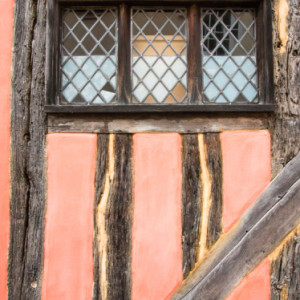Lavenham Guildhall
A couple of hours drive to Suffolk today, to carry out annual monitoring of a disused quarry with Chris. It was quite a strange day weatherwise - warm, breezy but also humid and heavy. We finished our work at about half-past four, and decided to break our journey home, so that we could avoid being caught in the rush-hour traffic round Cambridge, bad at the best of times, but potentially slower than normal because of major roadworks on the A14.
So rather than sitting in traffic queues, we had a very pleasant hour or so walking round the impossibly perfect village of Lavenham - a village packed with quaint Medieval and Tudor houses, with timber frames and paintwork in shades of white, orange and Suffolk pink (see extras) with scarcely a straight line anywhere. Suffolk Pink dates back to the 14th century, where pink shades were formed by adding natural substances to traditional limewash. For example elderberries release a beautiful carmine red. Other methods included mixing pig/ox blood with buttermilk which was then painted onto a house. Blackthorn or sloe juice was sometimes added too, to produce a redder pink.
Being late in the day, it wasn't too busy, but I can imagine walking round it at peak hours in the summer could be fraught, as it's a very popular tourist destination. I didn't really have the best lenses for photographing buildings (a tilt shift would have helped!) but still managed to take a surprising number of images, though the rather flat, grey sky wasn't the best. Of course the sun came out when we were driving home!
This is part of the Guildhall, now owned by the National Trust, who write:
"Lavenham has over 320 buildings of historic significance including Lavenham Guildhall, otherwise known as the Guildhall of Corpus Christi, which is possibly one of the best examples of them all.
In the 16th-century this picturesque village was the 14th wealthiest town in Britain, paying more tax than populous cities such as York and Lincoln, thanks to the quality of its renowned blue woollen cloth, which was in great demand.
However, by 1525 the bubble had burst. The demise of the cloth trade, for which Lavenham was famed, meant that the merchants had left looking for their next new venture. The local population was unable to maintain the timber-framed buildings, which had previously been funded by the enormous wealth created by the cloth trade and the buildings began to crumble.
By the 17th-century there was a threat of mass demolition. The situation was so severe that the Lord of the Manor took his tenants to court to prevent the destruction."
Fortunately for us, this threat was averted, and it remains a fascinating place to wander round.



Comments
Sign in or get an account to comment.


